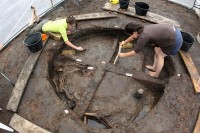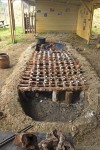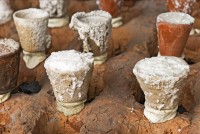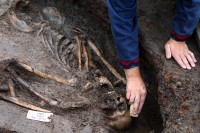 The skeletal remains of eight people have been unearthed in an ancient grain silo in Marsal, a town in the northeastern French region of Lorraine. The skeletons date to around 500 B.C. and were unceremoniously tossed into the silo so archaeologists found the bodies stacked on top of each other in random positions. Two of them were of children.
The skeletal remains of eight people have been unearthed in an ancient grain silo in Marsal, a town in the northeastern French region of Lorraine. The skeletons date to around 500 B.C. and were unceremoniously tossed into the silo so archaeologists found the bodies stacked on top of each other in random positions. Two of them were of children.
The discovery is unusual, the first of its kind in Lorraine, and may be connected with Marsal’s history as a major center for the production of salt. From the 7th to the 1st century B.C., there were extensive salt works in the area processing water from the salt springs of the upper valley of the Seille river. So far archaeologists have unearthed more than six miles of salt production complexes and at least a dozen individual workshops.
 This was production on an industrial scale. Workshops created clay grids on which little coarse ceramic molds not unlike Dixie cups in shape and size would be placed. The cups were filled with high salinity brine and wood-fueled fires lit underneath the grid. The water would boil away leaving only crystalized salt in the vessels. The molds were then broken apart, leaving a cone of salt of a conveniently standard size and a pile of broken clay. Excavations in the Marsal area have discovered trash piles of the clay discards from this process up to 40 feet high.
This was production on an industrial scale. Workshops created clay grids on which little coarse ceramic molds not unlike Dixie cups in shape and size would be placed. The cups were filled with high salinity brine and wood-fueled fires lit underneath the grid. The water would boil away leaving only crystalized salt in the vessels. The molds were then broken apart, leaving a cone of salt of a conveniently standard size and a pile of broken clay. Excavations in the Marsal area have discovered trash piles of the clay discards from this process up to 40 feet high.
 Salt’s value as a seasoning agent, and most importantly, as one of the only consistent, reliable and portable means of food preservation, made it so valuable it could be used as currency. The cones of salt left after the vessels were broken away could be traded for goods and services, just like money. That’s why their being regular in size and weight was so significant a production element, akin to the precious metal content of a coin.
Salt’s value as a seasoning agent, and most importantly, as one of the only consistent, reliable and portable means of food preservation, made it so valuable it could be used as currency. The cones of salt left after the vessels were broken away could be traded for goods and services, just like money. That’s why their being regular in size and weight was so significant a production element, akin to the precious metal content of a coin.
 Most relevantly to the skeletons in the silo, archaeologists have found an Iron Age necropolis used by the salt workers in the community, so dumping the bodies of these poor wretches in the silo was a deliberate choice. The grave goods in the necropolis burials include a range of objects of diverse value, the highest of which are expensive imports underscoring just how active and far-ranging the commercial activity of the site was, and that there was a distinctly hierarchical society in place there.
Most relevantly to the skeletons in the silo, archaeologists have found an Iron Age necropolis used by the salt workers in the community, so dumping the bodies of these poor wretches in the silo was a deliberate choice. The grave goods in the necropolis burials include a range of objects of diverse value, the highest of which are expensive imports underscoring just how active and far-ranging the commercial activity of the site was, and that there was a distinctly hierarchical society in place there.
 The remains found in the grain silo are all in good condition thanks to the watery and salty soil. Archaeologists hope testing can determine if these people worked in the salt workshops, if they were raised in the area, if they were related to each other, what they ate, what may have claimed their lives. Lead archaeologist Lawrence Olivier, who has been excavating Marsal and environs for a decade, believes they must have been people of low status, possibly slaves, perhaps victims of a massacre or an epidemic.
The remains found in the grain silo are all in good condition thanks to the watery and salty soil. Archaeologists hope testing can determine if these people worked in the salt workshops, if they were raised in the area, if they were related to each other, what they ate, what may have claimed their lives. Lead archaeologist Lawrence Olivier, who has been excavating Marsal and environs for a decade, believes they must have been people of low status, possibly slaves, perhaps victims of a massacre or an epidemic.
France’s National Institute for Preventative Archaeology (INRAP) has a comprehensive and fascinating website dedicated to Gallic salt production. If you don’t read French, browse it using an online translator because it’s downright illuminating. Here’s the section on the Bronze and Iron Age production that covers the period of the skeletons. Check the dropdowns for tons more information and pictures.
I am just absolutely tickled to see salt cones of a reasonably uniform size. I can just imagine using one with a small rasp to rind off salt like we would with one of the Mexican brown sugar cones!Imagine how easy it would be to tuck one wrapped in a scrap of parchment in a backpack to be used when you were standing ‘KP’ when your squad was cooking supper, or how handy it would be in the kitchen instead of having to worry about spilling the valuable salt, you rasp it off and rewrap it and set it safely aside.
Thank you for this very interesting post. The comment above, myers I found also very interesting. I worked on the archaeological spa site at Droitwich in England The site proved to be a Roman Salt works where Briquetage pots were found and used to store the salt. You can find this on my WordPress blog.
The arrondissement of Château-Salins (Saulnois or in Latin: Pagus Salinensis) in the said Moselle department has five cantons and 128 communes – Sounds indeed like a lot of salt.
As interesting as the salt discussion is (and it really is, especially the effort to standardize), my first reaction looking at the photos was:
–Bare feet?! and then:
–No gloves?!
I know academics are not typically subject to OSHA (never mind this is France, so equivalent). But common sense cross-contamination practices (not to mention hygiene) would suggest both footwear and gloves. Is this common practice?
I wonder why would somebody place multiple skeletons in a silo? Would it somehow affect the grain that was stored there? Was it an ancient crime scene? Another possible explanation is that maybe somebody placed the bodies to hide them and then the silo was built pretty much on the remains of those people. This way somebody was really trying to hide them.
Cathy J., while I can’t speak to this particular situation, in other scientific disciplines there are times when the evils of bare feet and hands are deemed less than the evils of the insensitive boot. For instance, there are places in the Lechuguilla Cavern where walking barefoot across an active flowstone formation to avoid tracking cave mud or removing boots to place bare feet more exactly in footprints through a gypsum crystal forest is a requirement. The bacteria and oils deposited in this case do much less damage to fragile features on the way to retrieve instrument data than the alternative.
So maybe it’s better for these remains that someone be able to feel them with toes and fingertips in the watery, salty soil, than to accidentally stomp on them with a boot when someone falls over, or to fracture some ancient nodule while trying to protect it with a sensory-impaired gloved hand.
Hopefully the excavators are resigned to coming down with an historical bug, if there are any malefactors left over from any plague that might have killed these people. :skull:
Every year all around the world people die accidentally in silos. So I’m not quite sure why the assumption here is murder, illness, or haphazard burial. Related family members or not, they could have simply been playing or working in the silo. Hence the positions they where found in. In grain silos, as long as the grain is not moving,footing stays firm so you can walk on it. But if a trap door is opened or any action resulting in flow…you drop like a rock and drown in it very quickly.